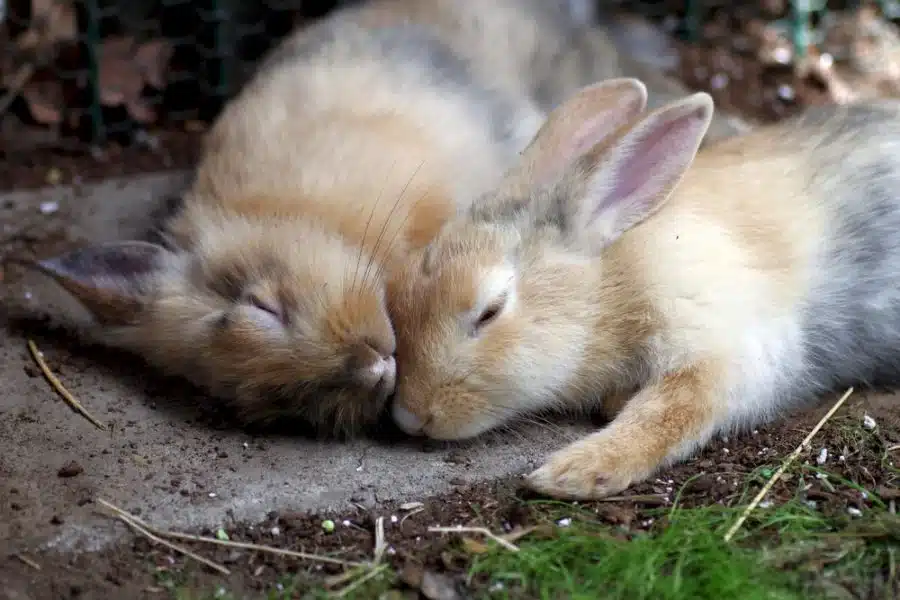Introduction
Are Rabbits Nocturnal: Welcome to the world of adorable and enigmatic creatures – rabbits. As we delve into the intriguing lives of these furry friends, one question frequently arises: Are rabbits nocturnal? This query opens the door to an exploration of their behavioral patterns, daily activities, and the remarkable adaptations that have evolved over time. While the answer may not be as straightforward as a simple “yes” or “no,” join us as we embark on a journey to uncover the captivating world of rabbit behavior and shed light on the mysteries of their activity patterns.
In the world of wildlife, few creatures have captured our imagination quite like rabbits. With their endearing appearances and remarkable adaptability, rabbits have found their way into our hearts and often, our backyards. Yet, despite their prevalence in both urban and rural environments, there remains a degree of mystery surrounding one of their fundamental behavioral traits: their activity patterns. Are rabbits truly nocturnal, creatures of the night that thrive under the moon’s glow, or is there more to their daily rhythms than meets the eye.
This inquiry into the diurnal rhythms of rabbits rodent delves into their evolutionary history, ecological roles, and behavioral adaptations to shed light on the fascinating question: are rabbits nocturnal? As we peer into the secret lives of these furry inhabitants of fields and forests, we begin to unravel the intricate interplay between their behavior and the natural world they call home.

What do rabbits do during the night?
Most rabbits will go to sleep between 10-12 pm. They’ll sleep until it’s time to wake up in the morning and start a new day. Like afternoon nap time, many rabbits will periodically get up to stretch and eat in the middle of the night.
Rabbits, those elusive and captivating creatures of the wild, engage in a range of fascinating activities under the cover of night. While they are often associated with being crepuscular, meaning they are most active during the twilight hours of dawn and dusk, rabbits do not completely retreat during the darkness of the night. Instead, they exhibit a mix of behaviors that ensure their survival, contributing to their unique role within the ecosystem.
Contrary to popular belief, rabbits are not exclusively nocturnal. During the night, they continue their foraging activities, seeking out plants, grasses, and other vegetation that constitute their primary diet. Their nocturnal feeding habits might be an adaptation to avoid predators that are more active during the day, allowing them to acquire sustenance with reduced risk.
Rabbits are known for their social nature, and this trait extends into the night. They often gather in groups, known as colonies or warrens, where they engage in various social behaviors. These interactions serve multiple purposes, including establishing hierarchies, sharing information about food sources and potential threats, and promoting overall group cohesion.
Are rabbits awake during the day?
Bunnies are “daytime” sleepers, sleeping for about six to eight hours each day. Much like deer, bunnies are crepuscular, which means they are most active during dusk and dawn. (In case you didn’t know, the word “crepuscular” is derived from the Latin word crepusculum, which means “twilight”.
Rabbits are classified as crepuscular animals, which means that they are most active during the periods of dawn and dusk. These twilight hours provide rabbits with a balance between the relative safety of darkness and the ample availability of light for foraging and other activities. During these times, their heightened senses aid them in locating food while minimizing exposure to predators.
While rabbits are not generally considered diurnal, they do exhibit some level of activity during daylight hours. It’s not uncommon to spot rabbits outside their burrows during the day, especially if they feel secure in their environment. Factors such as the presence of adequate cover, low predator activity, and the availability of food sources can influence rabbits to venture out during the day.
Rabbits might also be seen basking in the sun during the day. This behavior serves multiple purposes, including thermoregulation and parasite control. By exposing themselves to sunlight, rabbits can warm up their bodies and reduce the risk of certain parasites. However, they often choose locations that provide them with quick access to cover in case a threat arises.
Breeding-related behaviors can also lead rabbits to be more active during daylight. Courtship rituals, such as chasing and grooming, can occur during the day, as these activities are crucial for establishing and maintaining social bonds within rabbit communities.
Do rabbits sleep quickly?
|
Whilst humans (if we are lucky) will sleep through the night, rabbits wake up periodically at night, and sleep for quite lengthy periods during the day. They are prey animals, and need to be constantly alert for danger, so in general they sleep much lighter and for shorter periods than we do.
Rabbits are known for their short periods of sleep, often lasting just a few minutes at a time. This is in contrast to other animals, such as humans or cats, which engage in longer, more consolidated periods of sleep. Rabbits are vigilant prey animals, and their survival depends on being constantly aware of their surroundings to detect potential predators. As a result, they have adapted to sleep in brief intervals to minimize their vulnerability.
Rabbit sleep is characterized by a state known as “polyphasic sleep.” This means that instead of having a single, continuous sleep period, rabbits experience multiple short periods of sleep throughout the day and night. These sleep bouts can last anywhere from a few seconds to a few minutes, adding up to several hours of sleep over the course of a day.
The rapid sleep pattern of rabbits is closely linked to their natural history as prey animals. In the wild, rabbits face constant threats from predators, and their ability to quickly rouse themselves from sleep is a survival advantage. By keeping their sleep short and light, rabbits can be ready to flee at a moment’s notice, increasing their chances of avoiding capture.
Are bunnies intelligent?
Yes, it turns out that rabbits are very smart! Some breeds are even trainable. For example, you can teach a bunny to recognise their names and come to you when called. Rabbits also have a very good memory: they don’t forget negative experiences and emotions easily.
Bunnies are remarkably adept at learning and adapting to their environments. In both the wild and domestic settings, they quickly learn to navigate obstacles, identify food sources, and recognize potential dangers. Their ability to adjust their behaviors based on their experiences showcases a level of cognitive flexibility and problem-solving.
Bunnies are social animals, and their interactions with one another and their environment demonstrate a level of social cognition. In groups, they establish hierarchies and communicate through various body language cues, demonstrating an understanding of social dynamics within their communities.
Rabbits exhibit keen environmental awareness, being attuned to changes in their surroundings. They have a sharp sense of smell, vision, and hearing, which they use to detect predators, locate food, and find suitable shelter. Their ability to discern these cues showcases a level of sensory intelligence.
Bunnies are known to have good spatial memory. They can remember the layout of their habitats, locate food sources, and navigate complex environments. This skill is particularly evident in their burrow systems, which they construct with specific chambers for different purposes.
What do pet rabbits love?
Rabbits love nothing more than having the space to run around, play, dig and explore while enjoying a bit of ‘me’ time. Show your bunnies you love them by offering a secure environment where they can display these natural behaviours safely away from predators. A happy rabbit is a loved rabbit!
Rabbits are social animals that thrive on companionship. They often form strong bonds with other rabbits, so having a compatible rabbit companion can greatly enhance their well-being. If having more than one rabbit isn’t possible, spending quality time interacting with your bunny is crucial for their emotional health.
Rabbits have a natural propensity for play. They love engaging in activities that stimulate their minds and bodies. Providing toys, tunnels, and safe objects for them to explore, chew on, and manipulate can keep them entertained and prevent boredom.
Rabbits appreciate a stimulating environment. Create a living space that offers hiding spots, platforms for climbing, and different textures to explore. Changing their environment periodically with new toys and arrangements can keep their curiosity piqued.
What animal sleeps the least?
The animals that sleep the least include bullfrogs, impalas, alpine swifts, walruses, orca calves, dolphins, giraffes, horses, deer, elephants, sheep, goats, cows, and ants. Which animals sleep the most? The animals that sleep the most include koalas, pocket mice, sloths, brown bats, armadillos, opossums, and lemurs.
Dolphins are often considered one of the animals that sleep the least. These highly intelligent marine mammals have evolved a unique sleep adaptation known as “unihemispheric slow-wave sleep.” Unlike humans and many other animals, dolphins do not fully shut down both hemispheres of their brains during sleep. Instead, they sleep with one hemisphere at a time, while the other remains alert and active.
This adaptation is critical for dolphins to maintain basic functions such as surfacing for air and monitoring their environment for potential threats. While the exact amount of time dolphins sleep varies by species and environmental factors, they typically sleep in short bursts of a few minutes to half an hour throughout the day and night.
Giraffes are another example of animals with minimal sleep requirements. These towering herbivores, known for their long necks and distinctive spots, often sleep for only a few minutes at a time, typically around 4.6 hours per day. Their sleep is distributed across several short periods, and they often sleep while standing. This adaptation is believed to be a defense mechanism against predators, allowing giraffes to remain vigilant and quickly respond to potential threats.
How often do rabbits poop?
Average sized bunnies will make 200-300 poops per day. They should be uniform in size and shape which means rounded and pea to garbanzo sized.
One of the most interesting aspects of rabbit digestion is their practice of coprophagy, which means they consume their own feces. While it might sound unusual, this behavior is essential for their nutrition. Rabbits have a two-part digestive system: they initially process their food in the stomach and small intestine, and then re-eat a special type of feces called cecotropes. These cecotropes are produced in the cecum, a part of the digestive tract where essential nutrients are broken down and absorbed. Consuming cecotropes allows rabbits to extract essential nutrients that weren’t fully absorbed during the initial digestion process.
Apart from cecotropes, rabbits also produce regular droppings, which are commonly referred to as “pellets.” These are small, round, and dry in appearance. These droppings are excreted and are typically found scattered around the rabbit’s living space. Normal droppings indicate that the digestive system is functioning properly and that the rabbit is eliminating waste as needed.
The frequency of rabbit poop can vary based on factors such as diet, age, health, and activity level. Generally, rabbits tend to produce normal droppings multiple times a day. Some rabbits might poop as often as every 20 to 30 minutes, while others might do so less frequently. On average, rabbits may produce anywhere from 100 to 300 pellets in a single day.
How do rabbits play with humans?
How do rabbits play? Well, they like to push or toss objects around. They also might race madly around the house, jump on and off the furniture, and act like humans who have had too much sugar. Rabbits love toys, and some will play for hours with a favorite toy.
Rabbits love toys that engage their senses and encourage exploration. Provide toys such as cardboard tunnels, wooden blocks, and puzzle feeders filled with hay or treats. These toys simulate natural behaviors like digging, chewing, and foraging, keeping rabbits entertained and mentally stimulated.
Many rabbits enjoy gentle petting from their human companions. Start by petting them on their head, cheeks, or behind their ears, as these are areas they can reach themselves. Pay attention to their body language – if they nuzzle your hand, flop over, or close their eyes, it’s a sign that they’re relaxed and enjoying the interaction.
Allowing your rabbit to roam in a safe, rabbit-proofed area provides them with opportunities to explore and play. Sit on the floor and let them approach you at their own pace. Some rabbits may “binky,” which is a joyful hop and twist in the air, indicating their excitement and happiness.
Rabbits have a natural instinct to hide, and playing a gentle game of hide and seek can be enjoyable for them. Hide behind furniture or hold up a blanket, then peek out to see your rabbit’s reaction. Some rabbits might initiate a playful chase!

Conclusion
In the pursuit of understanding whether rabbits are truly nocturnal creatures, we’ve embarked on a journey through their intricate behavioral patterns and ecological roles. While the prevailing notion of rabbits as primarily nocturnal animals has been widely accepted, our exploration has revealed a more nuanced truth. Rabbits exhibit a degree of flexibility in their activity patterns, adapting to various environmental conditions and pressures.
Their crepuscular tendencies, displaying heightened activity during the dawn and dusk hours, highlight their strategic balance between safety and resource acquisition. This dual lifestyle enables them to capitalize on the advantages of both night and day, reducing their vulnerability to predators while maximizing their chances of finding sustenance.
Moreover, the evolutionary history of dream rabbits showcases their ability to adapt to different niches, whether in urban landscapes or natural habitats. This adaptability has blurred the lines between strictly nocturnal and diurnal behaviors, as rabbits have learned to thrive amidst human-altered environments.





No Comments